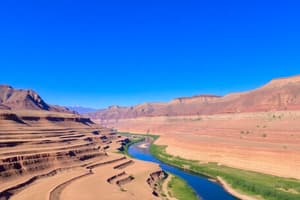Podcast
Questions and Answers
What constitutes the location where a river empties into another body of water?
What constitutes the location where a river empties into another body of water?
- River source
- Channel
- Riverbank
- Delta (correct)
Where is the source of water flowing into a river usually located?
Where is the source of water flowing into a river usually located?
- Channel
- Riverbank
- Delta
- River source (correct)
What is one of the defining parts of a river that is shaped by the speed of water flow and underlying sediment?
What is one of the defining parts of a river that is shaped by the speed of water flow and underlying sediment?
- River source
- Riverbank
- Delta
- Alluvial channel (correct)
What is historically important for human economy and transportation?
What is historically important for human economy and transportation?
What term refers to the adjacent land on either side of a river and often possesses rich ecosystems?
What term refers to the adjacent land on either side of a river and often possesses rich ecosystems?
What is the reason for the water in straight and sinuous channels to flow in a sinuous pattern?
What is the reason for the water in straight and sinuous channels to flow in a sinuous pattern?
What distinguishes anastomosing channels from braided streams in terms of their physical characteristics?
What distinguishes anastomosing channels from braided streams in terms of their physical characteristics?
How do scientists determine the age of sediments in alluvial channels using radiocarbon dating?
How do scientists determine the age of sediments in alluvial channels using radiocarbon dating?
What is responsible for the formation of natural levees in certain floodplains?
What is responsible for the formation of natural levees in certain floodplains?
How are terraces formed on the banks of alluvial channels?
How are terraces formed on the banks of alluvial channels?
What are the three basic bodies of water formed through alluvial patterns of water flow?
What are the three basic bodies of water formed through alluvial patterns of water flow?
What type of sediments are typically found in alluvial channels?
What type of sediments are typically found in alluvial channels?
Which type of channel is characterized by twists and turns in the landscape?
Which type of channel is characterized by twists and turns in the landscape?
What is a point bar in the context of meandering streams?
What is a point bar in the context of meandering streams?
In what kind of areas are braided streams typically found?
In what kind of areas are braided streams typically found?
Study Notes
River Terminology and Geography
- The location where a river empties into another body of water is called the mouth of the river.
- The source of water flowing into a river is typically located in higher elevations such as mountains or hills, where precipitation is collected.
River Morphology
- One defining part of a river shaped by the speed of water flow and underlying sediment is called the channel, influencing the river's morphology.
- Natural levees form along certain floodplains due to sediment deposition during overflow and flood events.
Human Interaction and Economic Importance
- Rivers have historically been crucial for human economy and transportation, facilitating trade and movement of goods.
River Ecosystems
- The riparian zone refers to the adjacent land on either side of a river, characterized by rich ecosystems that support diverse flora and fauna.
Water Flow Dynamics
- Water in both straight and sinuous channels flows in a sinuous pattern due to various factors, including changes in channel shape and flow velocity.
Channel Characteristics
- Anastomosing channels have multiple interconnected channels separating islands of land, while braided streams consist of intertwining channels with exposed sediments.
Sediment Age Determination
- Scientists utilize radiocarbon dating to determine the age of sediments in alluvial channels, often focusing on organic material found within sediment layers.
Geomorphology of Alluvial Channels
- Terraces on the banks of alluvial channels are formed by continuous sediment deposition and erosion cycles, leading to elevated flat areas.
Alluvial Water Bodies
- Three basic bodies of water that form through alluvial patterns include lakes, wetlands, and deltaic formations.
Sediments in Alluvial Channels
- Alluvial channels typically contain depositional sediments, including sand, silt, and clay, influenced by the river's velocity and flow.
Channel Types
- Channels characterized by twists and turns are referred to as meandering channels, which evolve over time through sediment erosion and deposition.
Meandering Streams
- A point bar is a sediment deposit formed on the inside bend of a meandering stream, arising from lower water velocity and sediment accumulation.
Braided Streams
- Braided streams are typically found in areas with high sediment supply and variable water flow, such as glacier-fed rivers or arid regions with occasional flooding.
Studying That Suits You
Use AI to generate personalized quizzes and flashcards to suit your learning preferences.
Description
Test your knowledge on alluvial channels, rivers, and freshwater bodies. Learn about the importance of rivers in human economy, transportation, and food resources. Explore different parts of rivers such as the source, riverbank, delta, and channel.




